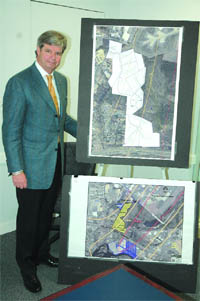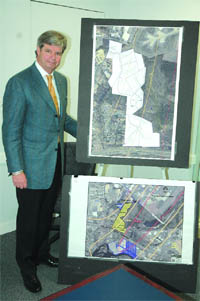
Getting Ready for Takeoff
AirPark South in Chicopee Will Give the Region Inventory, Flexibility

test
When the Home Depot Corp. purchased 70 acres for a new regional distribution facility in Westfields Campanelli Business Park in October, it heralded a major contribution to that citys commercial portfolio.
But it also took one of the last developable parcels of land that size off the market, creating a void in the regions inventory of commercial tracts. However, that void will only be temporary, thanks to a recent acquisition that will create a new industrial park to be called AirPark South in Chicopee.
The new facility, which will join parks covering the other compass points at Westover, should come online in 2013, said Blair, and when it does, it will be, at 110 acres, the largest contiguous parcel of developable industrial land in the region, giving the region both inventory and much-needed flexibility as well as the opportunity to compete for Home Depot-sized projects.
The searches for those big properties are infrequent, said Allan Blair, president of the Westover Metropolitan Development Corporation (WMDC). At the moment in time when you cut the ribbon and are ready to go forward with any new property of that size, then you are ready to compete for those few opportunities.
The need for developable land the region is a constant, he said, citing such property as the location for future larger growth and investment. If we dont stay ahead of the curve on the development of those sites, he continued, then at some point were not going to be able to compete with other regions because we wont have a place to put new construction.
The ink is still wet on the paperwork for the purchase of 57 acres for that new park from the city of Chicopee, and Blair noted that there are a few other deals in the final stages of negotiation. When all is said and done, he said, the opportunity will be unique, not just for the city and the region, but for the Commonwealth.
Come Together
It was around five years ago, Blair said, that the WMDC purchased 38 acres from Tarnow Nursery, the first parcel destined to become AirPark South. Adjacent to that property is the recently purchased land from the city, which historically had been zoned residential. It wasnt really developable, he explained. Access was a problem, and it fell within the contours of a noise-mitigation study done by the Federal Aviation Administration. That granted us access to funds from the federal government.
In January 2009, the talks began between WMDC and Chicopee, and by this past summer, the parties had agreed to a $1.45 million price for the parcel. There were voices within Chicopee that initially had been critical of what was seen as a relatively low price paid for the property, but a market evaluation assessment set the land at the final selling price.
When speaking to the press at the time of the closing, Mayor Michael Bissonnette said that he had hoped for a higher price tag for the 57 acres, but in the long run, a poor economy and a lack of alternatives quelled any lingering doubts. Also, he agreed with Blair that, in order to stay competitive within the commercial real-estate market, the WMDC had the best plan to put the property in motion.
Currently the wooded acreage is but a twinkle in any developers eye. A small access road between the municipal airport at Westover and the Covidian property on Padgette Street is the planned portal to the property. When the parcel is slated to go online for development in 2013, it will be the largest contiguous commercial property available within the region. Its probably the last big chunk of property that can be assembled in this way, Blair said, and quite possibly the last in the region of this size.
With the airport next door, and significant frontage along the Mass Pike, he said that the last iteration of the successful AirParks might very well be the most exciting of them all.
We want to make sure that this is planned properly, he continued, and that the uses have some vision in there that will make the highest and best use of the land. By that I mean creating significant jobs, significant taxes, or supporting industry clusters in our region that we have been trying to support as opposed to just any use, just to sell the dirt. Thats not how we operate.
Even though the property could be scooped up by one tenant, the proposals set on the boards envision the probability that the park will be parceled into as many as 17 sites. Roadways and utilities would be built out in phases as the properties sell. Thats pretty much how our other parks have developed, Blair explained. We started with a big chunk and then gradually developed the smaller pieces.
More than likely, he continued, were going to find users in the 50,000-to-100,000-square-foot range, so we will end up subdividing the property. But again, its important to have the ability to compete for those larger prospects.
The WMDC estimates that between 1,000 and 1,100 jobs will be created by the park, with projected tax revenues for the city ranging toward $1 million. For the city, its a good opportunity to turn fallow land into economic prospects, and, according to Blair, good news for the airport as well.
Weve protected the approaches to the runway by eliminating the potential for incompatible land uses, namely residential, he said. That was the reason for the FAAs willingness to invest in the property.
If You Build It, They Will Come
When asked about the marketing prospects for AirPark South, Blair said that its really too soon to speculate. Environmental-impact studies over the next few years will determine what those prospects will be. But he said that, to his understanding, it would be for mixed-use development: from, in his words, plain-vanilla industrial to high-end research and development.
A lot will depend on what the market demands are for the regions commercial interests in 2013, though. How will we need to compete, and what will complement our existing properties? he said.
Marketing the property will come about when those decisions are made, he said, but given the size and scope of the property, the sales pitch wont be too difficult.
Thats a good size even today in the marketplace, he said. Its very difficult to find such a parcel anywhere that has access to such good utilities.
The new property also comes at a good time for the future of Westover. Of the three other industrial parks comprising several hundred acres, only a handful of available acreage remains. They are close to being maxed out, Blair said.
With the sound of hammers ringing in the hallways outside his office at the airport, echoing the development to come around the corner, Blair said this latest project will be a good cap to development in that part of Chicopee.
This conversion of property from military to civilian use has been one of the most successful of its kind in the country, in terms of taxes and jobs, he said. More than $2 million in taxes are paid to Chicopee from AirParks North and West alone, every year, and have been since the mid-90s.
Pointing to the map next to him containing the new plans, Blair said, these are very important economic-development endeavors for the municipality, and for the region.






